Paris Fashion Week Men’s A/W 2024: Loewe to Hermès
The best of Paris Fashion Week Men’s A/W 2024 in our ongoing report, from Jonathan Anderson’s church of masculinity at Loewe to a consideration of pleasure from Véronique Nichanian at Hermès
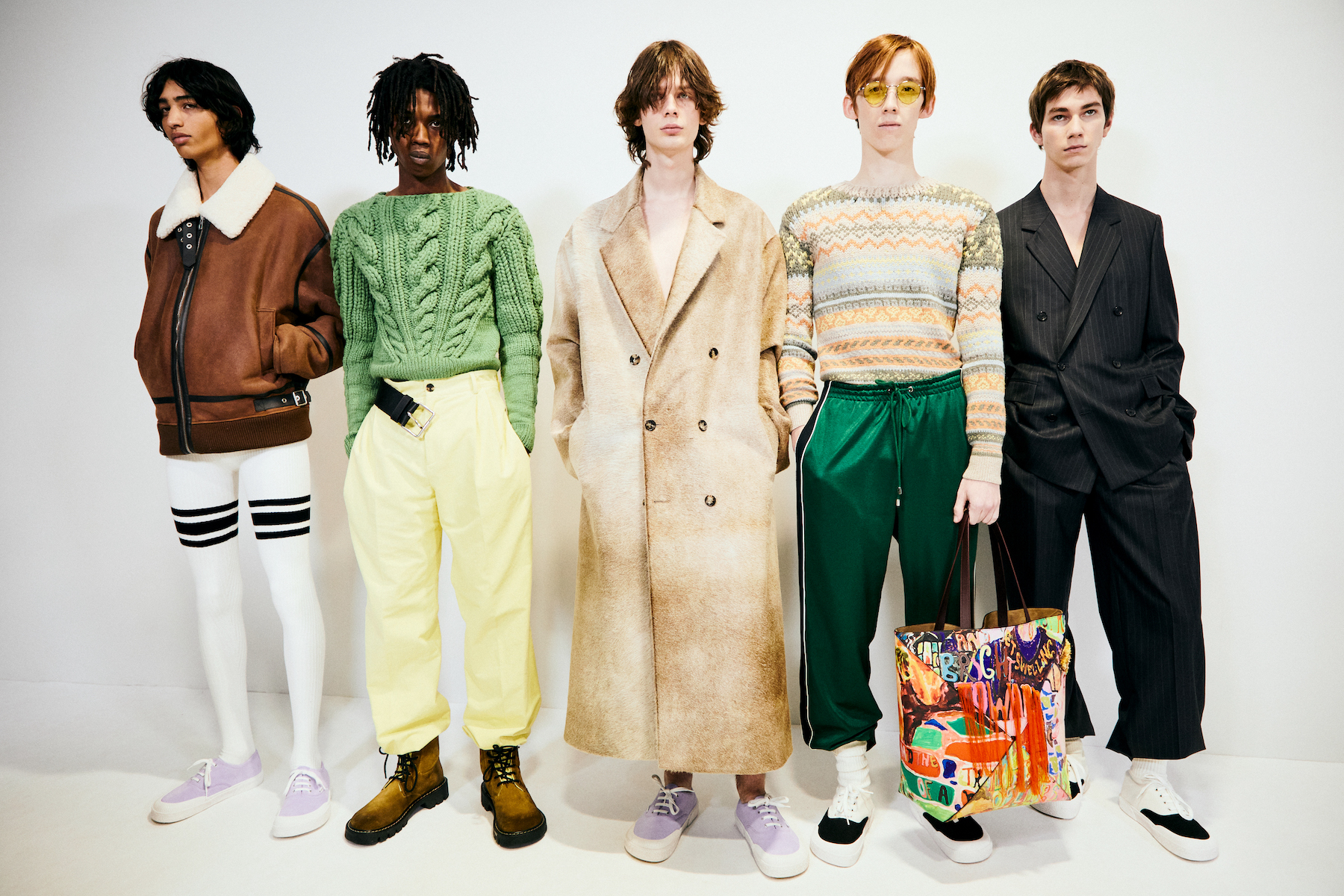
Paris Fashion Week Men’s A/W 2024 – the closing leg of men’s fashion month, concluded in the French capital this week. Having started with Pharrell Williams’ anticipated sophomore ready-to-wear show for Louis Vuitton – an ode to the American West and its distinctive dress codes – the week continued with Givenchy’s first show since the departure of Matthew M Williams (the collection will be designed by the in-house team), another Paris outing for British designer Grace Wales Bonner, and an intimate show from Rick Owens held at his Paris home.
Here, the very best of Paris Fashion Week Men’s A/W 2024, as it happened.
The best of Paris Fashion Week Men’s A/W 2024
Wooyoungmi
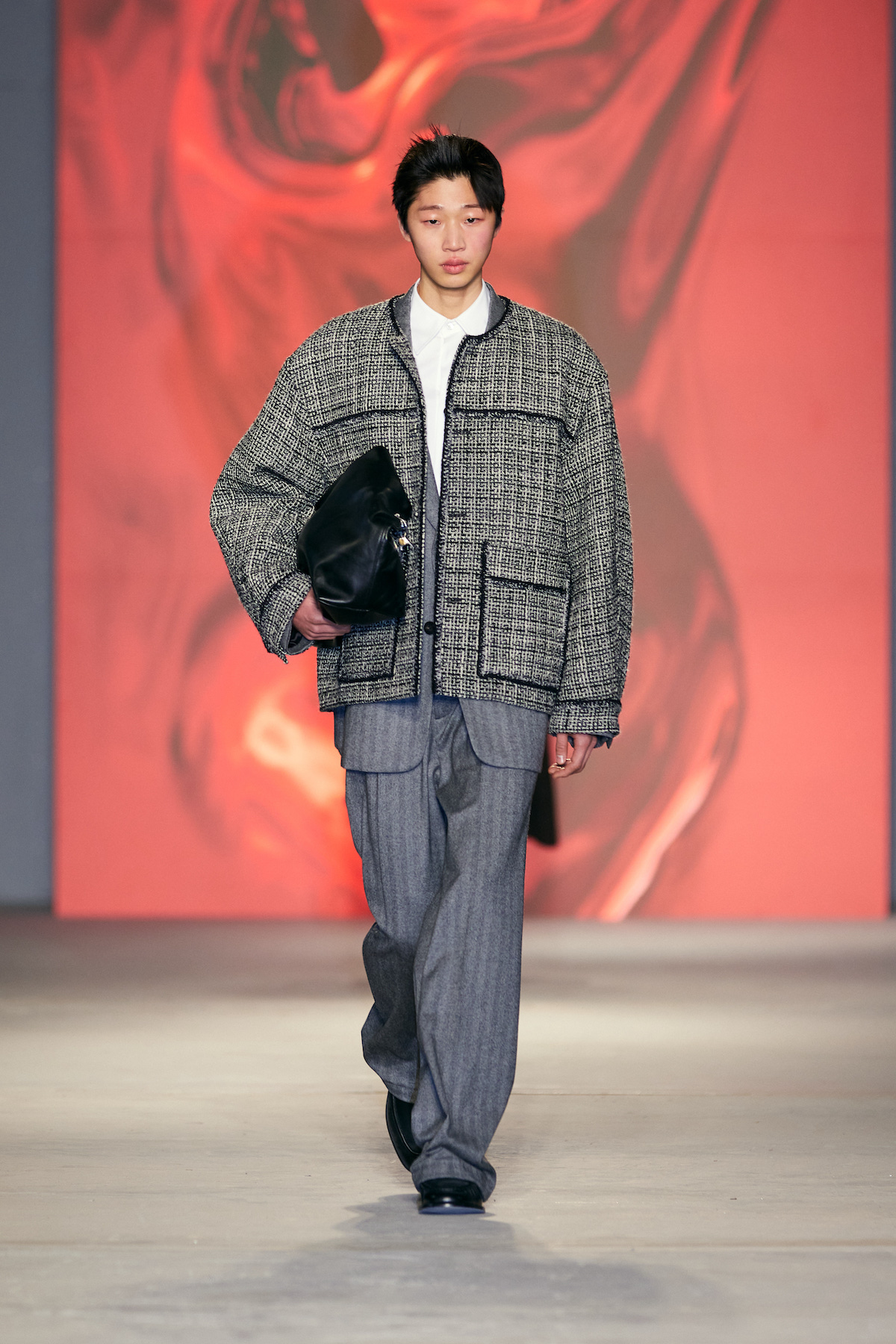
Wooyoungmi A/W 2024
The mythic allure of Seoul – as viewed through an outsider’s eye – was the starting point of Wooyoungmi’s latest collection. Youngmi Woo (better known by her moniker, Madame Woo) began the collection with a book by Scottish missionary Alexander Williams from 1870, somewhat surreally titled ‘Knowing About Korea Without Ever Going There’. The designer noted that even now – as Seoul becomes one of the foremost producers of pop culture, particularly music – the city remains ‘an idea: a faraway metropole like no other; a place many know about without ever going there’.
Here, she set about to create her own ’portrait’ of the city’s style, one informed by both reality and perception. Indeed, it was a collection infused with the easy, eclectic mood of the street – she said she wanted it to feel like observing a stream of particularly well-dressed passers-by – from wide-legged washed jeans worn with roomy baseball jackets to colourful rugby and football shirts, and playful riffs on corporate suiting (denim jackets and jeans were worn with shirts and ties for her dressed-up version of the Canadian tuxedo). Strongest, though, was a beautiful array of outerwear – a category that Madame Woo has long been astute at creating – from abbreviated pea coats to elongated styles in heritage fabrics, or blown-up versions of the classic women’s tweed jacket.
Valentino
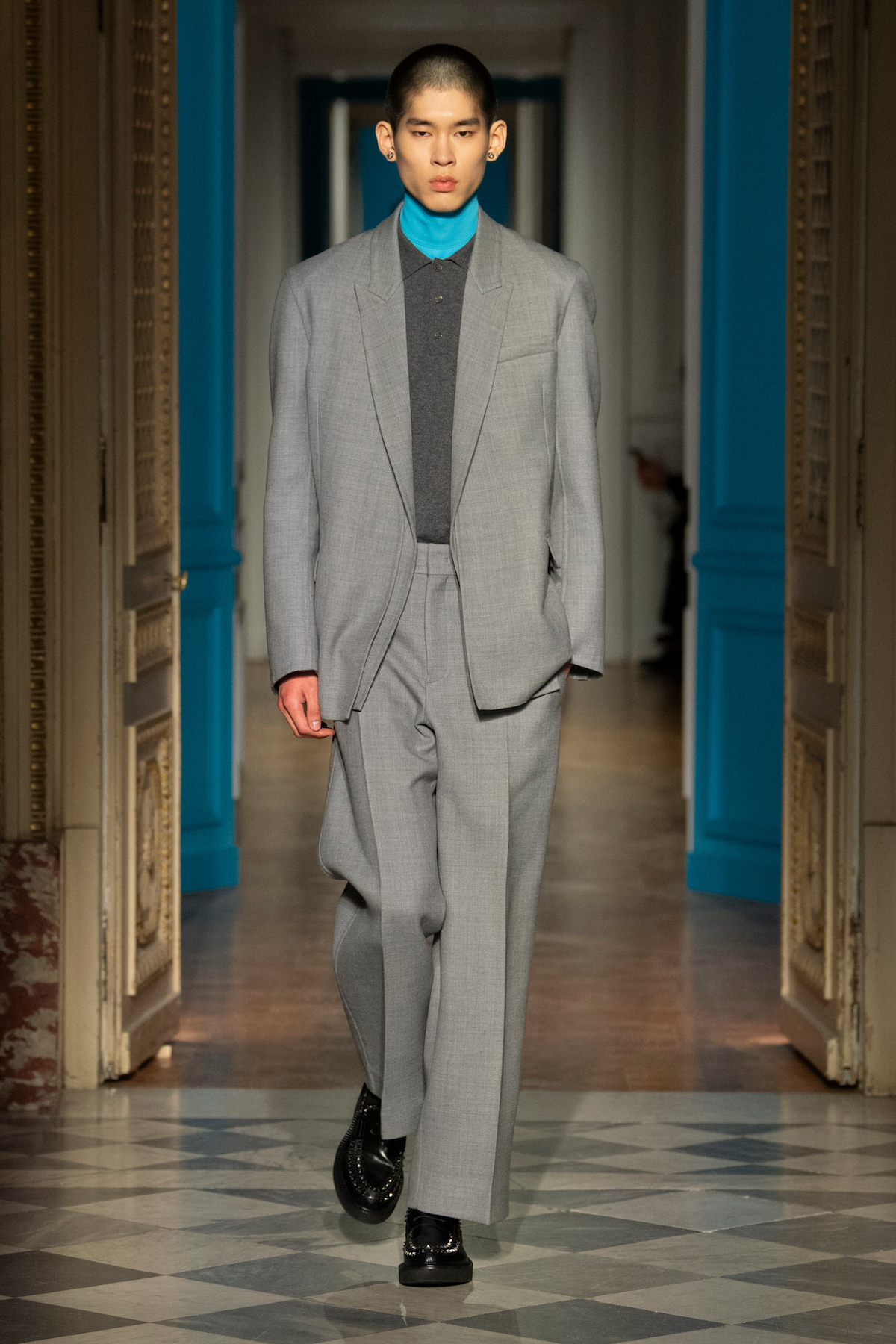
Valentino A/W 2024
Pierpaolo Piccioli has long used colour to conjure a particular mood (memorably, he presented an entire women’s collection in a single shade of pink, dubbed ‘Pink PP’ and granted its own Pantone colour). Here, it was breezy sky blue, which adorned both benches and doors in the ornate salons of Paris’ Monnaie de Paris for the designer’s latest menswear-only show (last season, Valentino returned to the menswear calendar having previously been shown co-ed during womenswear fashion month). The choice hinged on an exploration of contemporary manhood, the colour with which blue is now associated, particularly after the birth of a child. But Piccioli said he was thinking about how colour can be resignified – traditionally, he said, blue was associated with femininity, the shift only happening in this century – hoping to present it here as something fluid, a mood which extended to the clothing itself, seeing archetypal menswear garments, like the traditional Italian suit, cut with a softer line or embellished with moments of decoration recalling the house’s haute couture collections.
Hermès
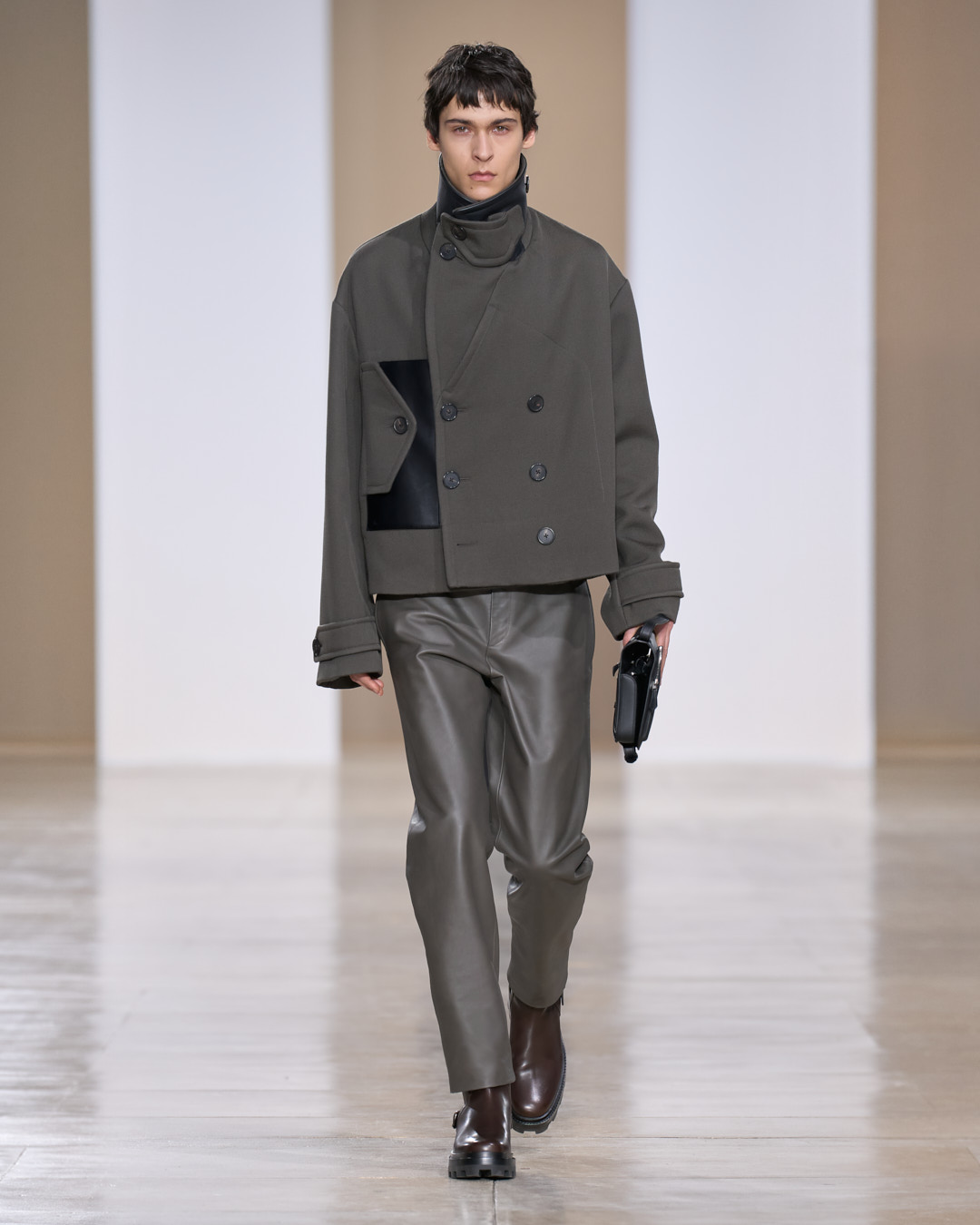
Hermès A/W 2024
Véronique Nichanian’s approach to Hermès menswear is to capture a feeling of pleasure through clothing: an endless search to create garments which please both visually and physically, a balance she has struck in her over-three-decade-long tenure so far. Yesterday’s menswear show provided a gamut of options for the Hermès man come next winter, particularly in the way of outerwear, from a beautiful shearling-lined leather parka to shorter leather peacoats adorned with a collage of utility pockets (in Hermès’ playful parlance, these were pockets that ‘slip and slide’). Elsewhere, a melange of knitwear – some adorned with painterly prints and presented in layers – met riffs on heritage checks, like Prince of Wales plaid, which ran throughout. Typically seductive adornments came in the way of accessories: versions of the house’s roomy Haut à Courroies carry all came in textures of smooth barénia and sombrero calfskin, while a smaller, book-size bag came with utility pockets and was grasped in the hand. A final flourish came in an array of eveningwear, including a tailored jacket and coat in calf hair leather, cut with a narrow, elegant line.
Loewe
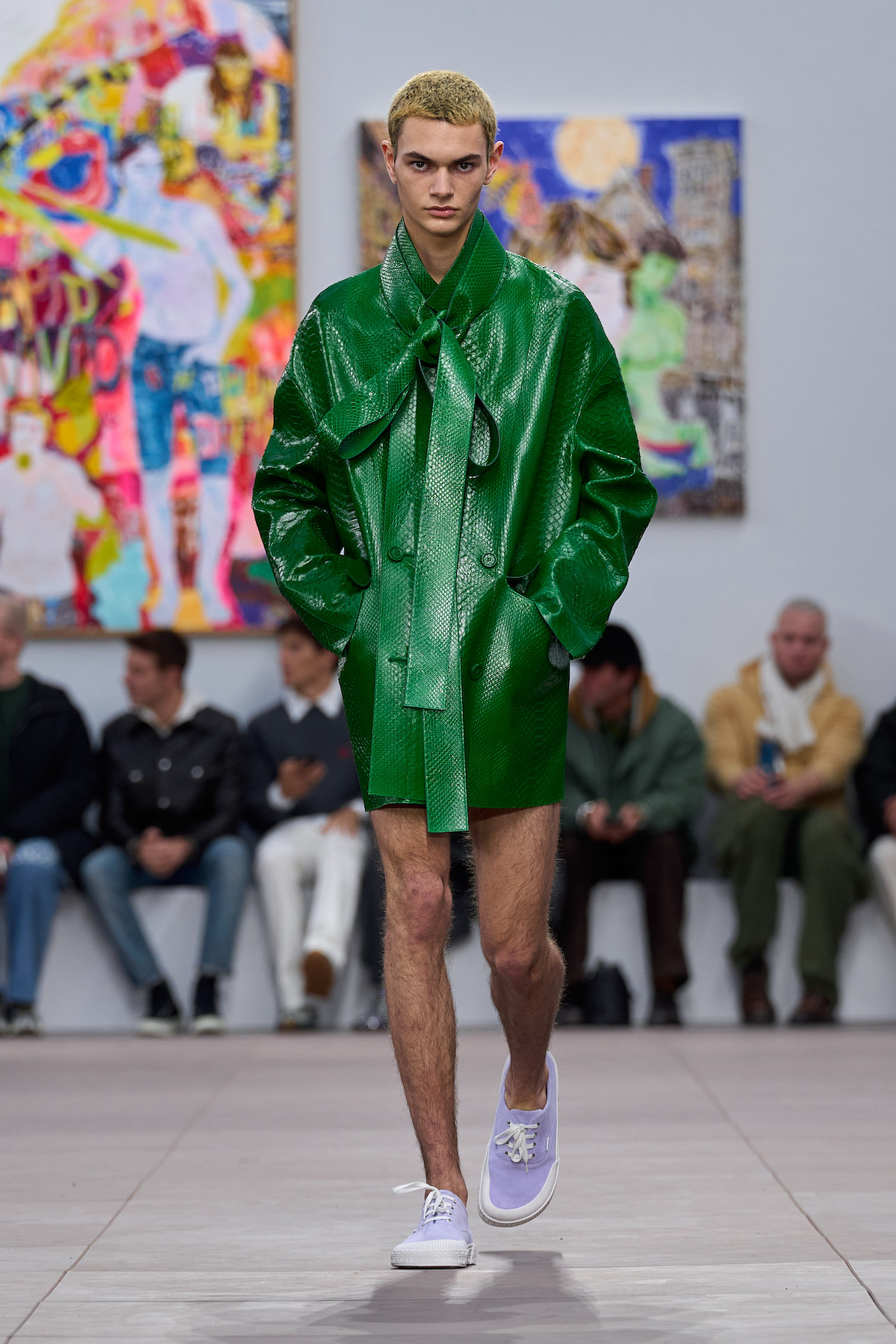
Loewe A/W 2024
Los Angeles-based artist Richard Hawkins provided the starting point for Jonathan Anderson’s audacious fall outing for Loewe, set amid a strange cathedral to masculinity where ‘stained-glass window’ screens buzzed with images of the designer’s phalanx of celebrity devotees – from Jamie Dornan and Josh O’Connor to Omar Apollo and Manu Rios. They had filmed themselves on their iPhones, preening their reflection, while around them Hawkins’ dizzying collages flickered, capturing the artist’s fixations, which span Roman statuary, French decadence and contemporary celebrity culture, as well as depictions of masculinity and the male body, which is the through line of his work. At the end of the runway were a series of Hawkins paintings; after the show, Anderson called it the ‘altar’.
Receive our daily digest of inspiration, escapism and design stories from around the world direct to your inbox.
The idea of collage – of ‘collaged realness,’ as Anderson described – ran throughout the collection, which had a mood of irreverence and youth. Enormous leather cargo pants were worn with baseball sneakers and skewiff checkered shirts; sweatpants, elongated sweaters and handbags were adorned with Hawkins’ saturated works; while stacked up layered garments appeared in colourful glimpses from beneath a long overcoat, as if the model was concealing a pile of laundry. An elegant riff on the trench – with a dropped tie waistline – came in leather, while riffs on the pussybow emerged in a melange of textures, alongside fairisle knits. A visual trick, meanwhile, came in a pair of trousers attached to a pair of socks, which were in turn attached to a pair of shoes. ’You're kind of telling someone: this is what you're wearing. You can’t get away from it, it’s like the media,' Anderson described.
It emerged from the designer’s observation about the way modern life has ‘become a collage’; a never-ending stream of algorithmic images combining like Hawkins’ works, which in some ways predicted the way we consume visual culture today (he has been working on these pieces for over 30 years). ‘I’m looking at this idea of iconography,’ said Anderson. ‘It’s all about different types of validation… how we perceive ourselves to the outside world. It’s a new psychology. What that means in the future, I don’t know – but I think it can be exciting.’
Comme des Garçons Homme Plus
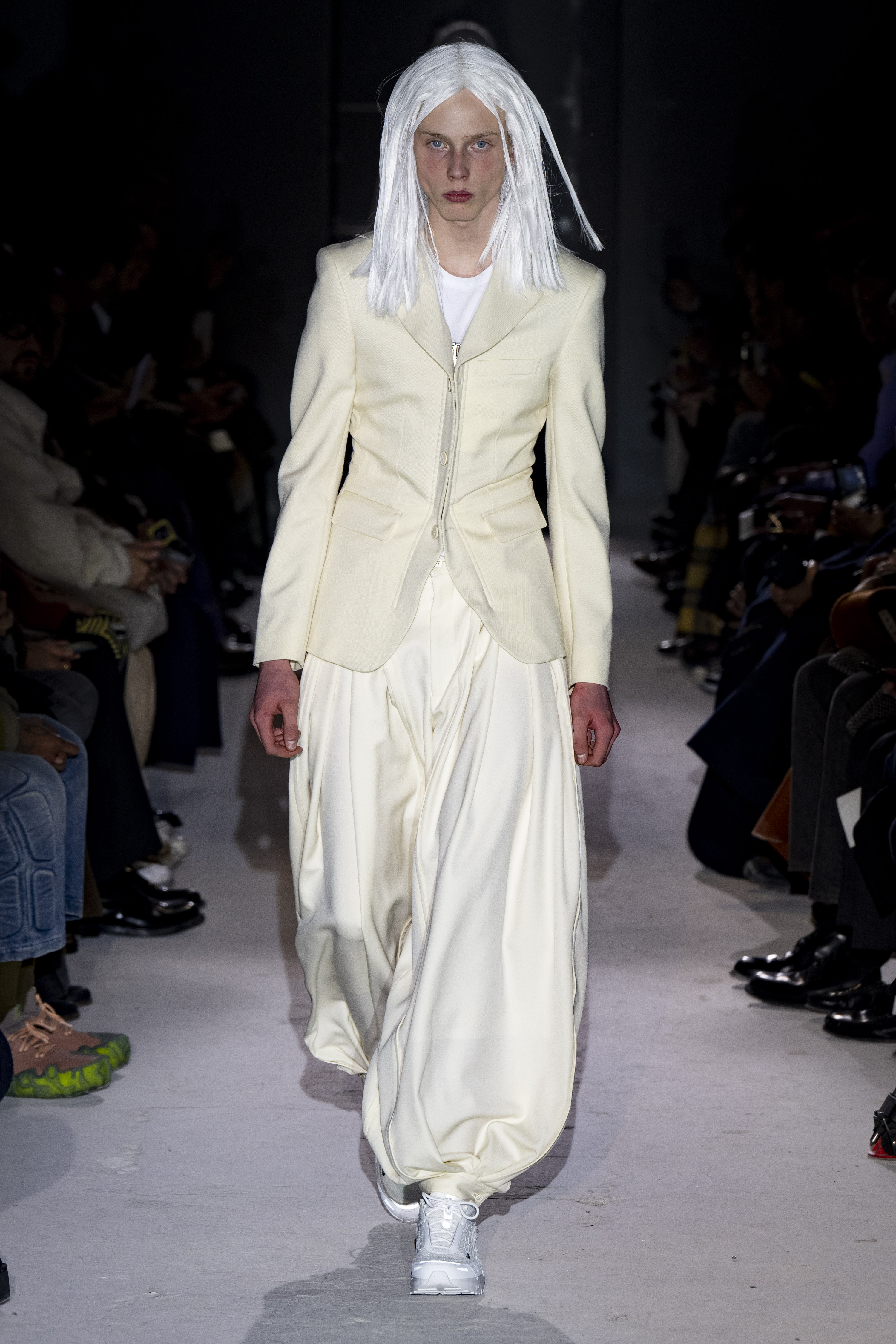
Comme des Garçons Homme Plus A/W 2024
There was a striking simplicity to Rei Kawakubo’s latest menswear outing, which largely eschewed the more unconventional silhouettes of the Japanese brand’s womenswear collections towards what was at its essence a studying in tailoring (albeit in the designer’s idiosyncratic, imporvisational style). Largely in shades of white, cream and ecru – ‘white is symbolic of prayer,’ was all Kawakubo offered in her typically enigmatic press notes – tailored jackets were nipped tightly across the chest (some with double lapels, or sliced away in sections), while trousers had a generous volume, ballooning just above the ankles (other jackets were worn with wide, elongated shorts or pleated kilts). Embellishment came in the form of rows of stitched-on white buttons or glimpses of sequins revealed beneath blazers and knits, while the final flourish came from playful headpieces by Gary Card, made from wrapped up garments from Comme Des Garçons ubiquitous ‘Play’ line.
Dior Men
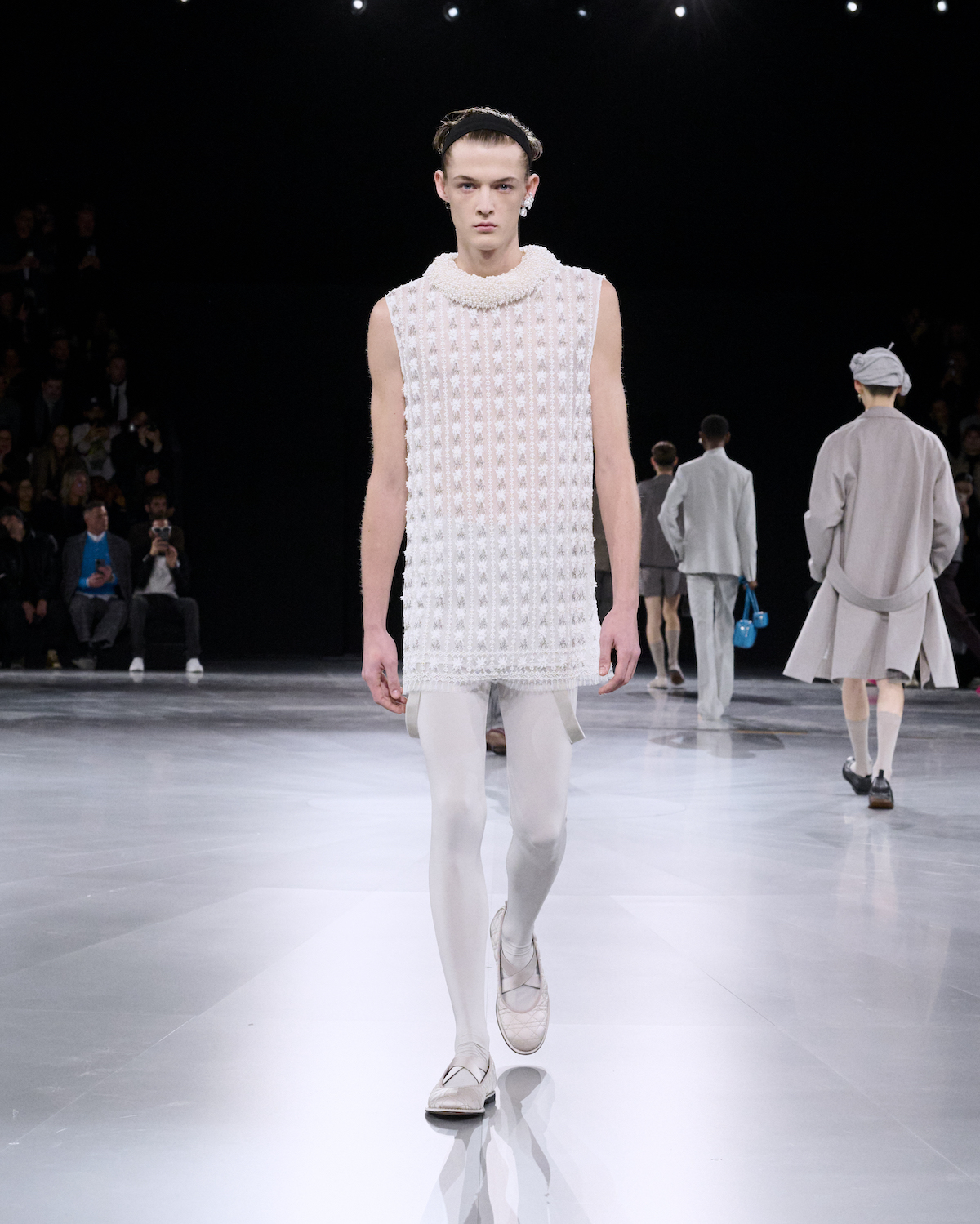
Dior Men A/W 2024
The invitation for Kim Jones’ latest Dior show featured a photograph of Soviet-born ballet dancer Rudolf Nureyev, who in a much-mythologised grasp for freedom defected to the West on a 1961 trip to Paris. It was taken by Jones’ uncle, a photographer and former ballet dancer who had struck a friendship with Nureyev and documented his life in the West in a series of images which for the show had been collated by his nephew in a book left on attendees’ seats. ‘Nureyev is entwined with my personal history because of my uncle,’ explained Jones. ‘I had been thinking about the relationship between the ballet dancer Margot Fonteyn and Monsieur Dior. The masculine interpretation of this involved thinking about her most famous dance partner, Nureyev.’
The heady liberation which Nureyev has come to epitomise (the famous Daily Express headline the day after his defection ran ‘Dance to Freedom’) inspired one of Jones’s strongest outings for the house yet. Divided into ready-to-wear and couture – the latter twenty looks were a demonstration of the extraordinary abilities of the Dior atelier – the collection moved from rehearsal room to stage (fittingly, the show was presented in the round to the booming sounds of ‘Dance of the Knights’ from Prokofiev’s Romeo and Juliet ballet score, as reinterpreted by Max Richter). ‘The collection – or rather collections, are about contrast: the contrasts in the house of Dior in terms of ready-to-wear and haute couture,’ explained Jones. ‘It’s the difference between onstage and backstage; the life of Nureyev theatrically and in reality. Here it is a meeting of the dancer’s style with that of the Dior archive.’
So there were twisting turbans by Stephen Jones evoking those worn by Nureyev in the dance studio (other models had their hair scraped back with thick black bands), wide tailored shorts worn with white socks and a masculine riff on the ballet pump, or a series of lightweight zip-up ribbed knits which plunged low on the neckline like ballet cardigans. Tailoring, meanwhile, had a feeling of lightness and fluidity, gently flared and based on archival pieces from Yves Saint Laurent’s tenure at the house. The final flourish of couture looks – which at the end were heralded by being raised high on a rotating platform as if models were dancers in a music box– were perhaps Jones’ most theatrical expressions yet, from an extraordinary beaded white tabard with a thick collar of pearls (worn here with white tights and ballet pumps decorated with the house’s cannage motif) to a kimono-style cape, based on a style Nureyev wore throughout his life, which took three people a staggering ten months to complete.
Paul Smith
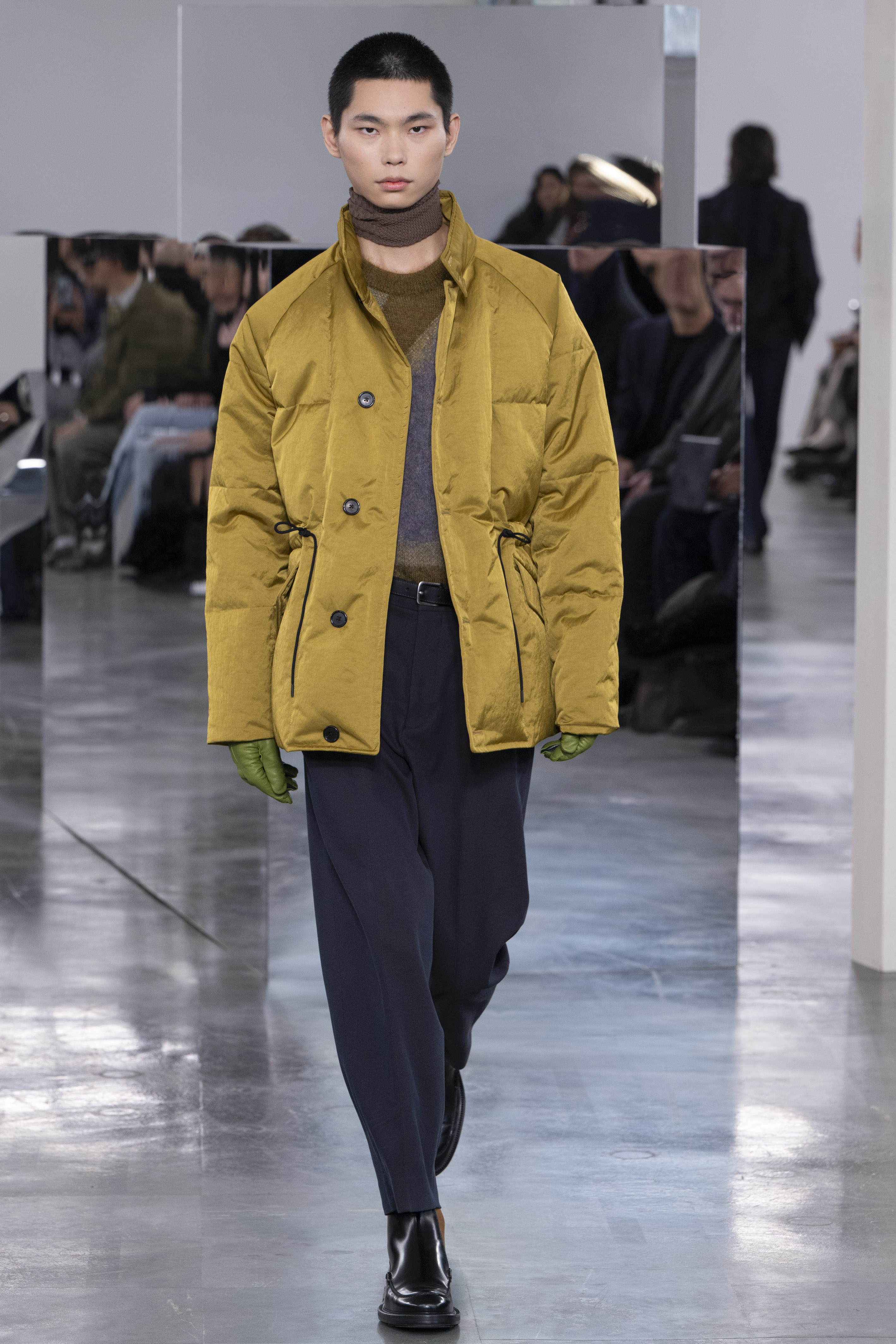
Paul Smith A/W 2024
Paul Smith noted that this latest collection was a demonstration of the motto that you have to know the rules in order to break them. His career has been defined by the dictum, whereby a deep-rooted knowledge and respect for British tailoring has been enlivened and reinterpreted through the designer’s witty, eclectic use of colour and print. This dichotomy was on full display in this latest collection, which combined hallmarks of British style – WW2 rider jackets, classic overcoats, padded gilets – with modernist-inspired colours, prints and motifs, including a ‘Photogram’ print inspired by Man Ray’s hazy ‘Rayograph’ images, ‘a trailblazing technique which stood as its own rebellion against the restrictive norms of the day,’ as Smith described. Colours, meanwhile, spanned deep purples, navies and browns, with flashes of lime green and ochre, while Smith’s vividly hued ‘Signature Stripe’ motif appeared across layered cardigans and knit sweaters.
Junya Watanabe MAN
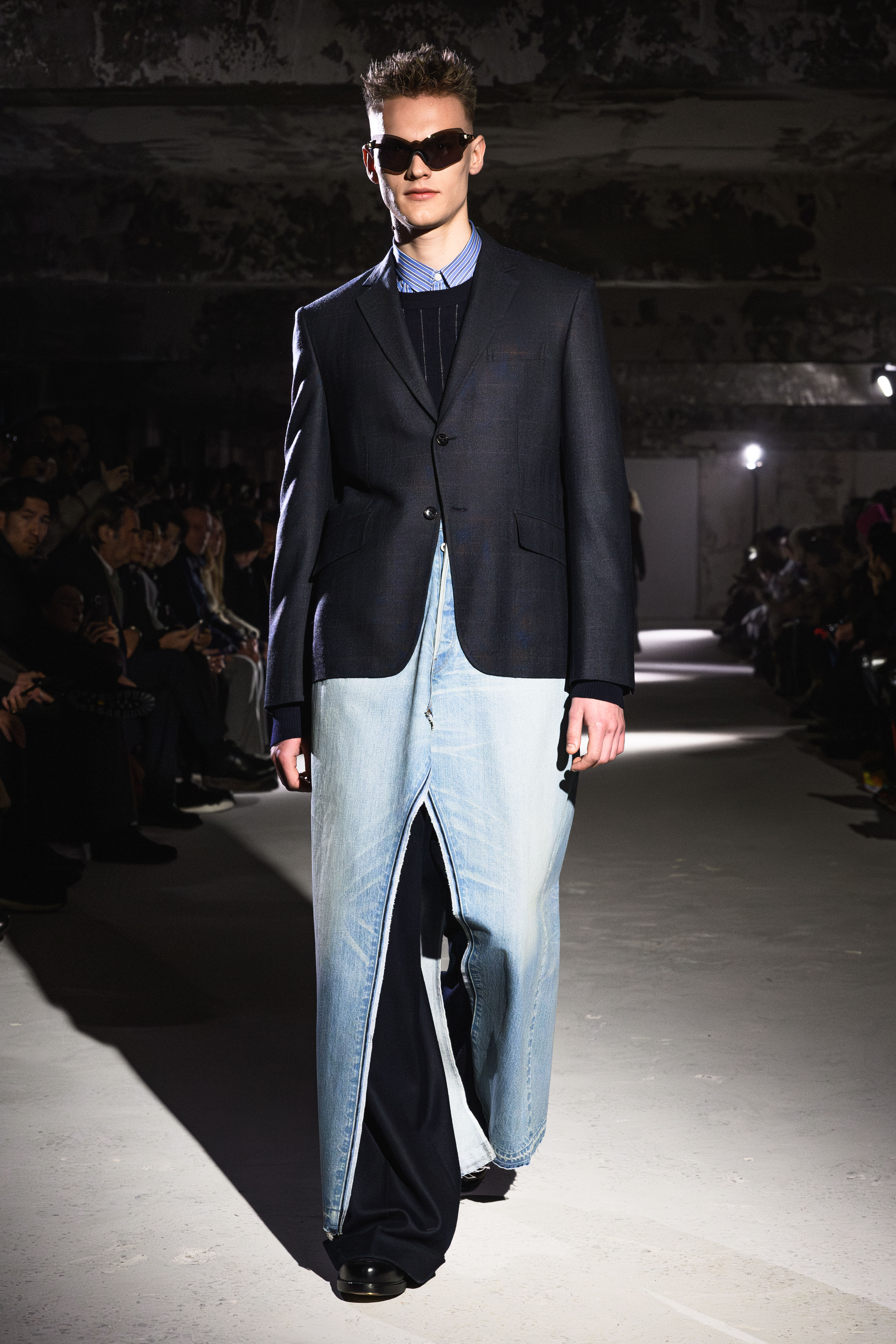
Junya Watanabe MAN A/W 2024
A multi-generational cast appeared in Junya Watanabe’s latest collection, which was titled ‘Reconstructed Suiting’. ‘I wish for men of different generations to wear these suits,’ was all that Watanabe offered in way of description, though there was certainly a mood of the quotidien to the outing, which largely played on hallmarks of men’s style – from tailoring to denim jeans, striped shirts and hoodies. A sense of hybridity ran throughout the individual garments: a tailored jacket, for example, was extended into a coat with the addition of a panel evocative of a classic trench, while others were overlaid with panels of chinos or jeans. Coats, which were held onto the body with a panel across the chest, and worn with classic pinstripe pants, heralded a shift towards simplicity, though Watanabe’s more distinct hallmarks – namely patchwork – continued to appear throughout. And, despite the mood of reduction, Watanabe’s desire for collaboration does not seem to abate; here, versions of (among others) Brooks Brothers, Palace and Carharrt’s own signature styles were reassessed with the Japanese designer’s distinct, disruptive eye.
Homme Plissé Issey Miyake
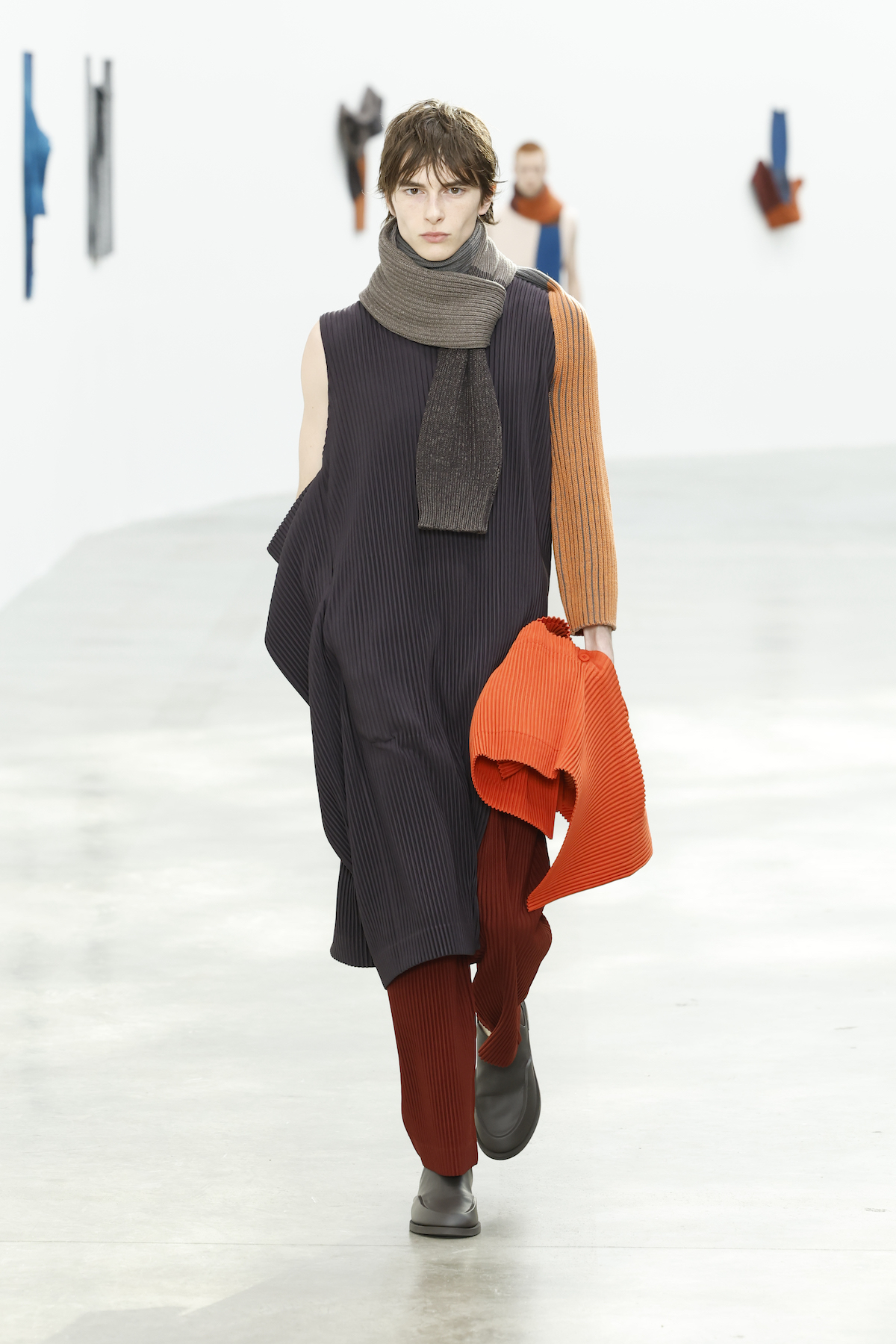
Homme Plissé Issey Miyake A/W 2024
Homme Plissé Issey Miyake’s latest collection was born from a collaboration with the polymathic French artist and designer Ronan Bouroullec. Here, the design team looked towards his drawings – colourful abstract forms which he draws each morning using a Japanese felt tip brush – which in the collection were used as adornment across the brand’s pleated separates, or informing its freewheeling mood, which this season had an improvisational air (a series of colourful scarves, for example, were draped around the model's bodies to recall Bouroullec’s work).
As such, the collection was titled ‘Immersed in the Wilds of Creativity’ and was an attempt to explore the translation of creative materials (here, Bouroullec’s oeuvre) into clothing. It made for a liberated mood, seeing beautifully layered silhouettes – many of which had the feeling of having been wrapped or loosely twisted around the body – meet moments of artistic flourish, such as a trio of models who carried cushions decorated with motifs reminiscent of Bouroullec’s work in their hands.
Amiri
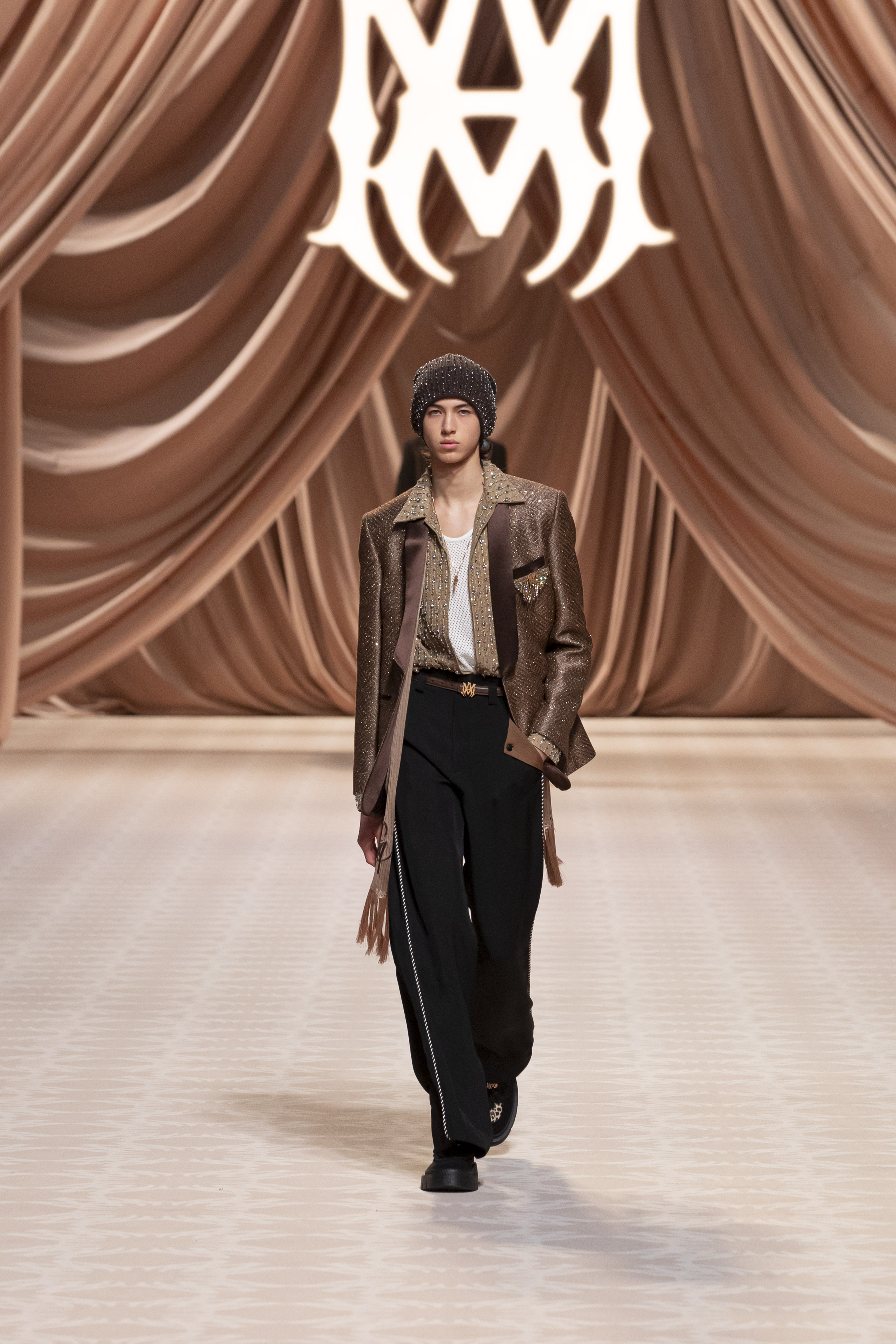
Amiri A/W 2024
A suitably dramatic set – enormous velvet curtains, an expanse of monogrammed carpet – provided the backdrop for Mike Amiri’s latest collection, which the American designer described as an ode to the Hollywood epic. Inspired by the nostalgic glamour of his home town of Los Angeles, louche tailoring was a focus – whether elongated satin blazers, jacquard evening jackets, or suiting with a loose, pyjama cut – which was inspired at once by Old Hollywood dress codes and the undone glamour of the 1990s. Befitting the inspiration, the shimmer of crystals ran throughout the expansive collection, whether as stacked-up brooches adorning the lapels of jackets or twinkling across undone shirts and beanie hats.
Rick Owens
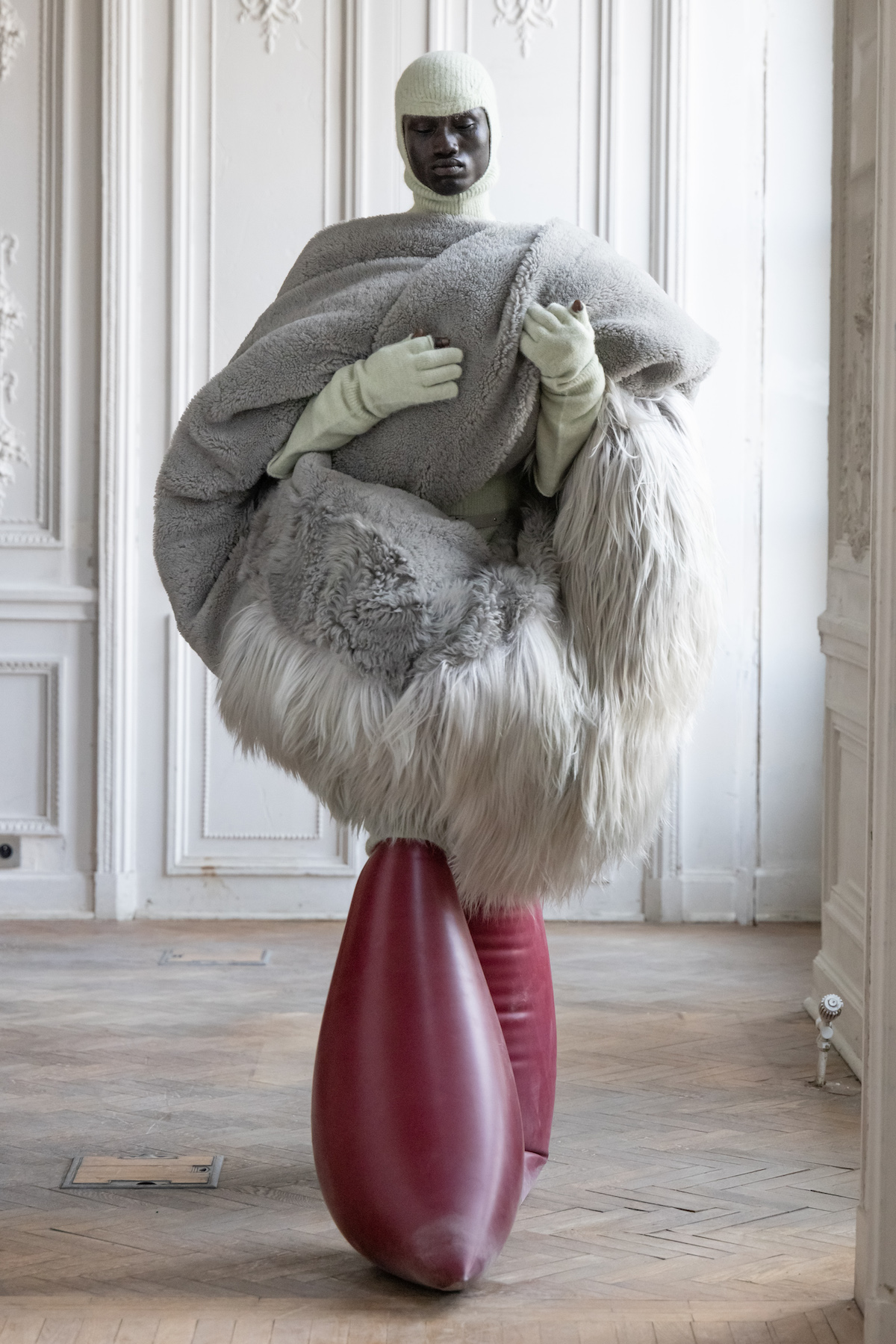
Rick Owens opened the door to his Parisian home on Paris’ Place du Palais Bourbon to host his latest menswear show, titled ’Porterville’ (a reference to the Californian city where the designer was born and grew up). Held amid the vast concrete rooms, sparsely decorated with Owens’ monolithic furniture, he chose the intimate location – a stark opposition to his usual shows held on the forecourt of the Palais de Tokyo – as a sign of ‘respectful restraint’ in response to world turbulence (recent seasons have seen him grappling with creation during times of war and crisis).
Here, the balm was community; Owens invited Steven from Fecal Matter and Gena Marvin – both known for their strange, otherworldly looks – to walk the runway, while collaborating with London-based designer Straytukay on inflatable footwear, and rubber-wear specialist Matisse Di Maggio on pieces crafted from recycled tyres. A mood of envelopment and solace ran throughout; enormous shaggy forms wrapped around the body in a suggestion of protection, while knitted all-in-ones were crafted in soft alpaca, cashmere and merino.
Wales Bonner
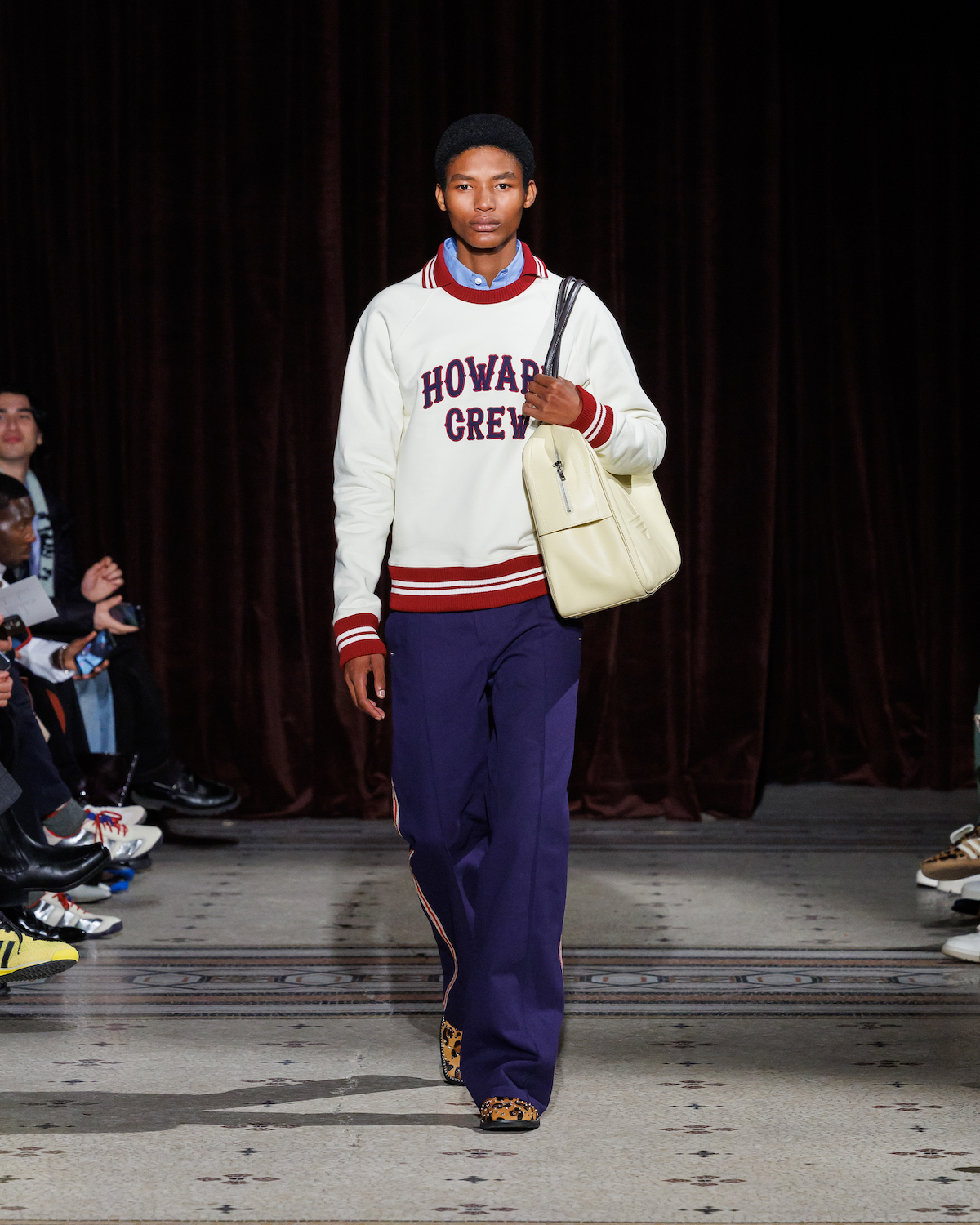
Wales Bonner A/W 2024
British designer Grace Wales Bonner has long riffed on the hallmarks of American collegiate style in her oeuvre. She returned to them this season, with a typically poetic show held in Paris’ Conservatoire National des Arts et Métiers. Howard University, a storied Black institution in Washington DC (alumni include Zora Neale Hurston and Toni Morrison), was at the collection’s centre: ‘a celebration of [its] shining lineage’, ‘where depictions of homecoming resound: hip-hop performances, readings from the poets, international gatherings on the green’. In this spirit, a live performance came from musician Yasiin Bey.
The collection itself clashed the college uniform – from Howard Crew-adorned sweaters to monogrammed varsity and baseball jackets – with moments of elegance and craft, from crocheted mirrors across tailoring (created by hand in India) to beads, pearls and amethysts adorning jewellery and brooches, which suggested a ceremonial flourish. Ceremonial too was a beautiful black tuxedo – perhaps recalling the moment of graduation – which the designer created alongside Savile Row tailors Anderson and Sheppard. The mood of refinement continued to her latest Adidas Originals collaboration, which comprised miniature handbags and versions of the Superstar sneaker in crocodile-embossed leather.
Givenchy
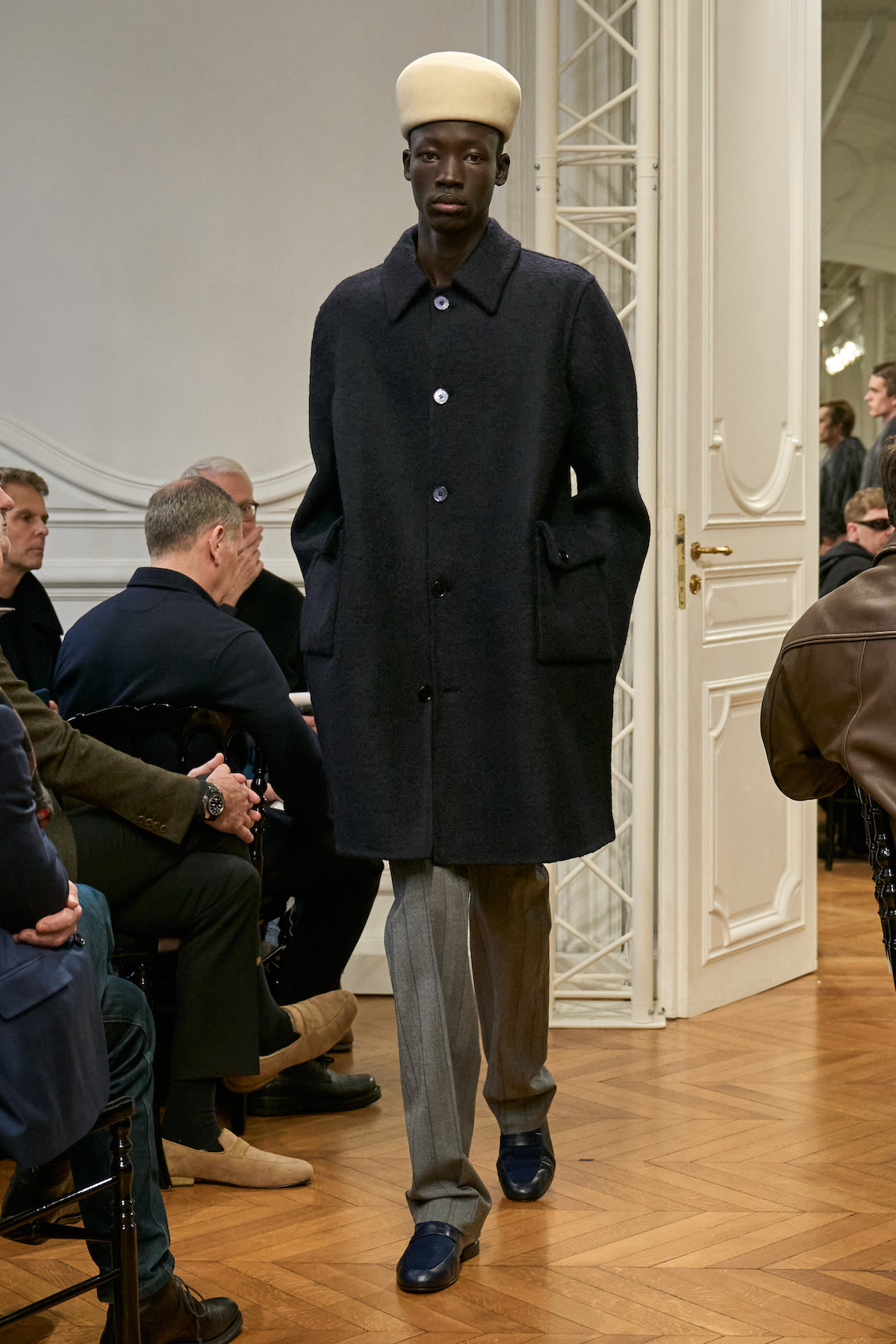
Givenchy A/W 2024
The house’s historic haute couture salon in Hôtel de Caraman on Paris’ Avenue Georges provided the setting for Givenchy’s first runway show since the departure of American designer Matthew M Williams late last year. Befitting the location – in which Hubert de Givenchy worked for 36 years – the show transpired like a traditional salon presentation, with guests sitting around tables in the space’s various white-walled rooms (madeleines, truffle sandwiches and champagne completed the mood of refinement). Designed this season by an in-house team (the new creative director is yet to be announced), the press notes said the collection began with a consideration of ‘gentlemanliness’ inspired by Mr Givenchy and his dress codes: ‘the duality of his public and personal wardrobes: a sartorial formality energised by an inimitable off-duty sense for nonchalance, flamboyance and seduction’.
It made for an eclectic offering. There were cat-adorned vest tops and fronds of synthetic hair, which crept out from under tailored jackets or adorned dramatic overcoats, ladylike silk headscarves (based on a style from the archive), louche, unbuttoned silk scarves, layers of knitwear, and sculptural hats. Tailoring, of course, ran throughout, in various iterations – some sliced away along the sleeves, others playing on classic eveningwear – though it was largely double-breasted and narrow in silhouette. At the end of the show, no one came out to take the final bow. Who will do so come next season remains to be seen.
Lemaire
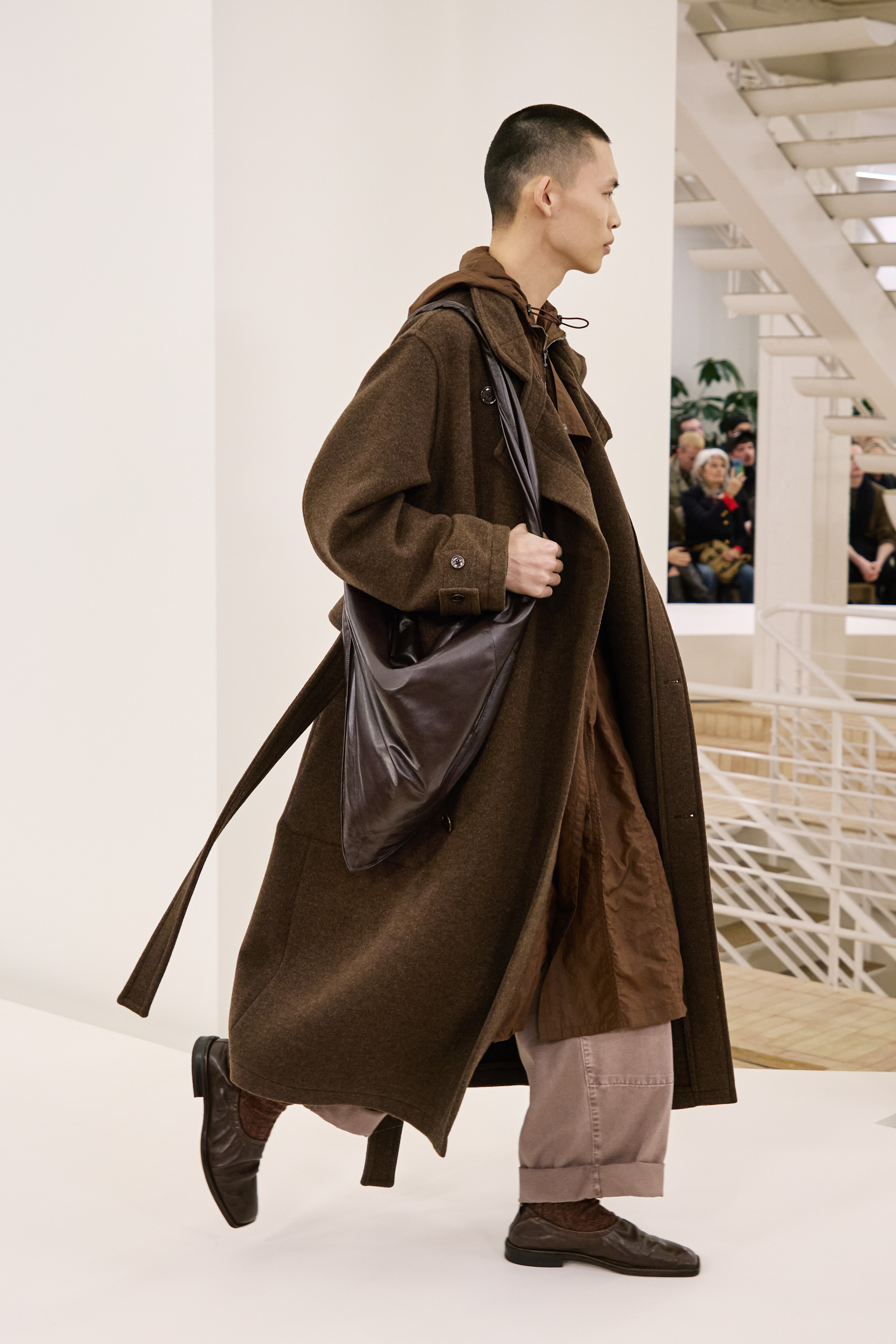
Lemaire A/W 2024
Lemaire’s latest show was staged in the brand’s airy, white-walled headquarters in Paris’ Place des Vosges. Warm herbal cocktails were served in the covered courtyard before the show – a balm to the day’s cold, drizzly weather – adding to the intimate feel of the presentation, which suggested an invitation into the brand’s serene inner sanctum. As such, the clothing itself, which largely evolves season on season rather than any more dramatic shifts, continued to hone the brand’s signature look, one of discreet, uncomplicated elegance (one already underscored by the staff at the show, chicly dressed in varying tones of Lemaire ecru and off-white).
Christophe Lemaire, who runs the eponymous label with Sarah-Linh Tran, noted that he felt like now was the right time to invite people into this space, which comprises the brand’s entire operation, including the atelier and workshop. As such, they talked about the collection as capturing the solace of home: enveloping, layered looks which took their cue from dance attire in the way pieces caressed the body like ‘a second skin’. Others subverted the domestic for wear out of doors, like elegant ‘in-and-out pyjamas’ or outerwear which recalled the proportions of a bathrobe.
Louis Vuitton
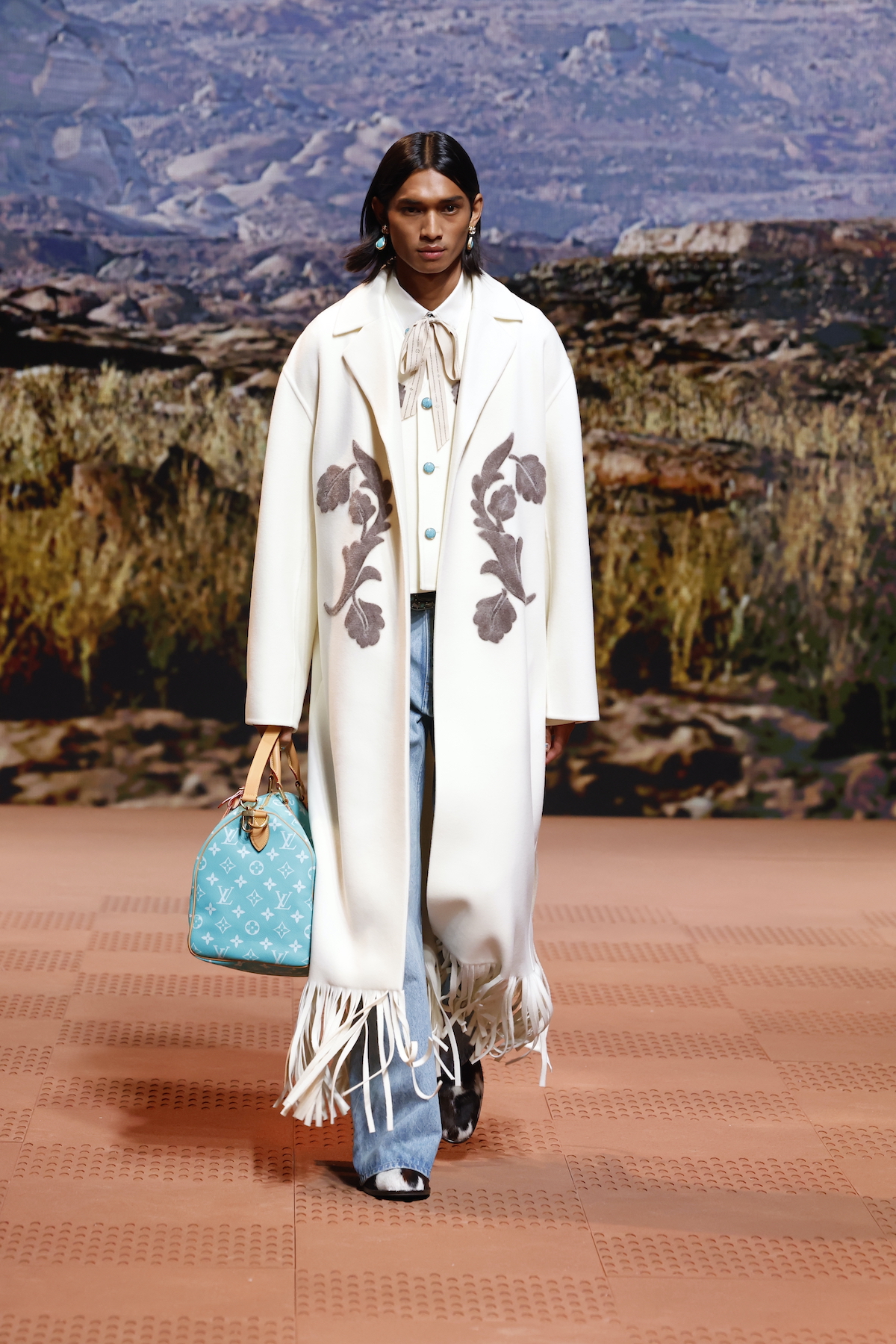
Louis Vuitton
It was out to Paris’ Bois de Boulogne for Pharrell Williams’ sophomore ready-to-wear show for Louis Vuitton. This follows his debut last summer in Paris, and a subsequent pre-fall collection, where the designer had erected an enormous box in the shadow of Frank Gehry’s sweeping Fondation Louis Vuitton. Inside the A/W 2024 show venue, vast projections lined the walls depicting the rocky plains of the United States, providing a hint of what was to come (the invitation, an LV-branded cowboy hat and an engraved harmonica, provided another). Here was Williams’ ode to that most American of archetypes: the cowboy, albeit filtered through the Parisian sensibilities of Louis Vuitton (‘Paris to VA’, in reference to his home state, is a continuing motif in his tenure so far). So, there were denim chaps and cowboy hats, Western-style shirts with frilled yolks and pearl-and-sequin adornment, and riffs on workwear, from a tailored take on the traditional double-kneed carpenter’s pant to a footwear collaboration with Timberland. Requisite cowboy hats completed the look, while enormous gilded Louis Vuitton trunks were wheeled along the runway on wooden frontier carriages.
Before the show, Williams noted that part of the reason for this collection was to provide a more expansive vision of the cowboy trope (Black and Native American cowboys were among some of the first cowboys in the United States, though they have been largely excluded from contemporary depictions of the era). As such, the collection contained a ’creative exchange’ with artists from the Dakota and Lakota nations, who assisted with Williams’ vision for the collection, including a version of the house’s ’Speedy’ bag, which was embroidered with a Dakota Flower motif, or ’Keepalls’ which featured designs reminiscent to those found on ‘parfleche’, stretched buffalo hides which were historically decorated by Native American communities. To close the show, powwow group Native Voices of Resistance – clad in designs conceived by Dee Jay Two Bears of the Standing Rock Sioux Tribe – performed as a gentle flurry of snow fell from the ceiling, the projected desert on the walls now dusted white. It made for a show that spoke of Williams’ vast, energetic vision for Louis Vuitton – all that was left to wonder is where the designer will take his odyssey next.
Stay tuned for more from Paris Fashion Week Men’s A/W 2024
Jack Moss is the Fashion & Beauty Features Director at Wallpaper*, having joined the team in 2022 as Fashion Features Editor. Previously the digital features editor at AnOther and digital editor at 10 Magazine, he has also contributed to numerous international publications and featured in ‘Dazed: 32 Years Confused: The Covers’, published by Rizzoli. He is particularly interested in the moments when fashion intersects with other creative disciplines – notably art and design – as well as championing a new generation of international talent and reporting from international fashion weeks. Across his career, he has interviewed the fashion industry’s leading figures, including Rick Owens, Pieter Mulier, Jonathan Anderson, Grace Wales Bonner, Christian Lacroix, Kate Moss and Manolo Blahnik.
-
 Issey Miyake’s HaaT flagship in Kyoto transforms a former sugar store into a pink-hued haven
Issey Miyake’s HaaT flagship in Kyoto transforms a former sugar store into a pink-hued havenRenovating a traditional timber building dating back over a century, the Issey Miyake offshoot’s new Kyoto store is a conversation between past and present
-
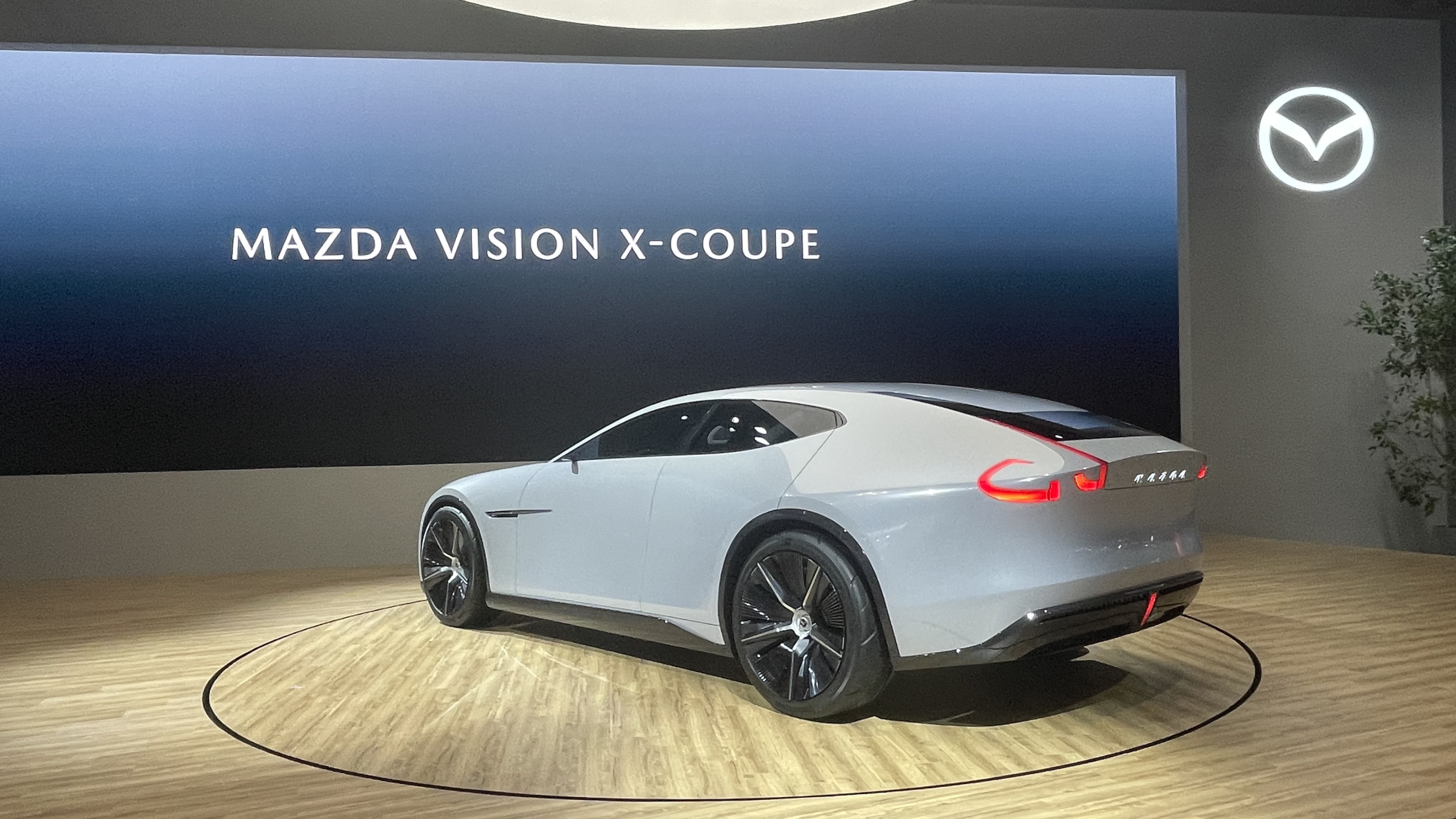 Wheels of the weird and wonderful: how the 2025 Japan Mobility Show met its brief
Wheels of the weird and wonderful: how the 2025 Japan Mobility Show met its briefWe bring you our selection of the ten most futuristic concepts and fascinating forthcoming machinery at Tokyo's Japan Mobility Show
-
 Find solace in the forest at this expansive treehouse retreat in Dorset
Find solace in the forest at this expansive treehouse retreat in DorsetFor sale for the first time, a treehouse, Mallinson’s Woodland Retreat, is a tribute to the skill of designer and master craftsman Guy Mallinson
-
 Issey Miyake’s HaaT flagship in Kyoto transforms a former sugar store into a pink-hued haven
Issey Miyake’s HaaT flagship in Kyoto transforms a former sugar store into a pink-hued havenRenovating a traditional timber building dating back over a century, the Issey Miyake offshoot’s new Kyoto store is a conversation between past and present
-
 Introducing the iPhone Pocket, a joyful new accessory from Apple and Issey Miyake
Introducing the iPhone Pocket, a joyful new accessory from Apple and Issey MiyakeCarrying your device just got a colourful new twist thanks to the iPhone Pocket, a celebration of the two companies’ shared design DNA
-
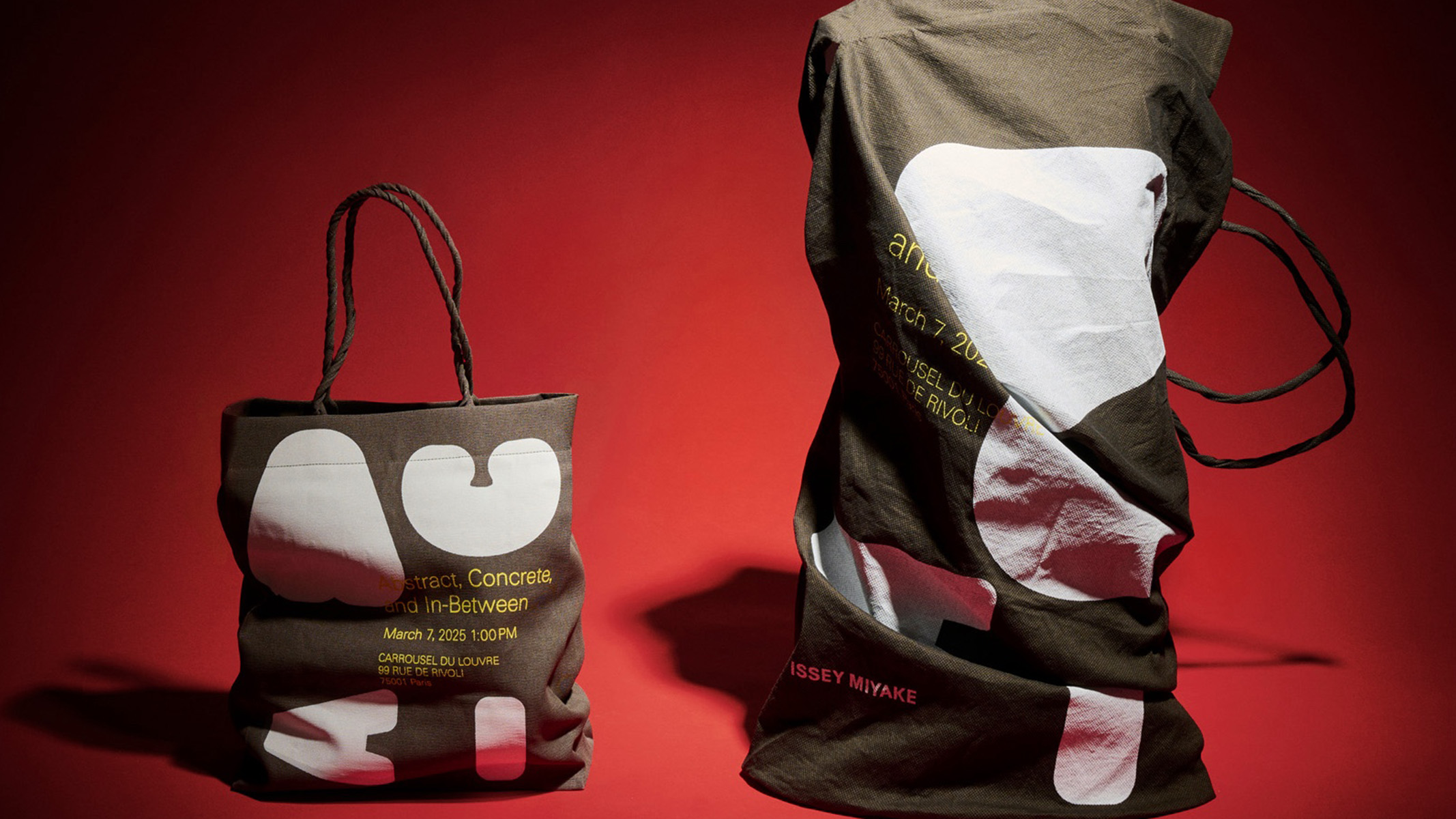 Issey Miyake’s shape-shifting A/W 2025 collection transforms the paper bag into something you can wear
Issey Miyake’s shape-shifting A/W 2025 collection transforms the paper bag into something you can wear‘Can anything be considered a garment, as long as it’s on the body?’ says creative director Satoshi Kondo of the art-infused collection, which sees the everyday reimagined
-
 Frieze London 2025: all the fashion moments to look out for
Frieze London 2025: all the fashion moments to look out forThe best fashion happenings to add to your Frieze London 2025 schedule, from Dunhill’s curation of talks at Frieze Masters to an exhibition of furniture by Rick Owens
-
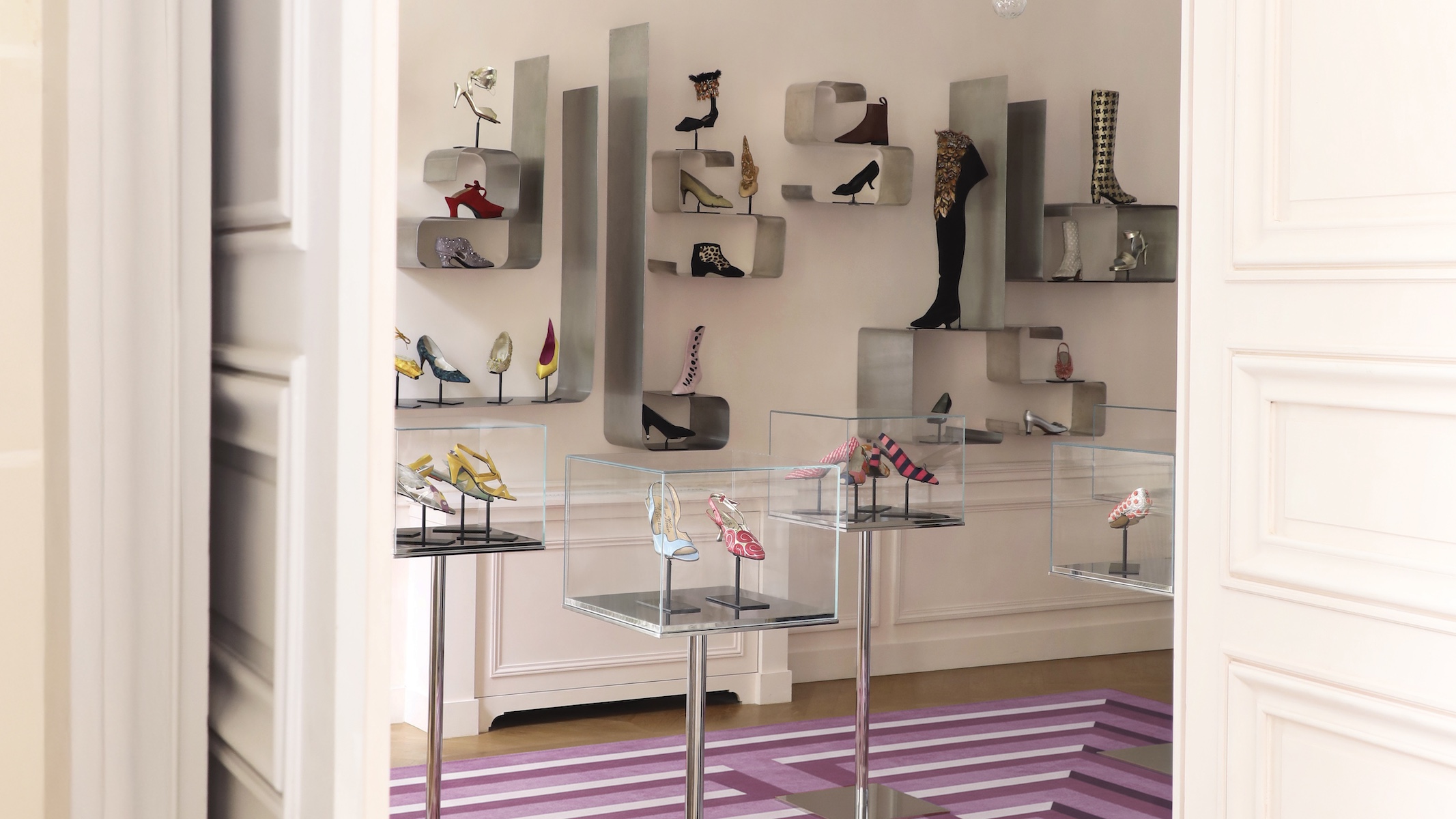 Inside Roger Vivier’s opulent new Paris HQ and archive, a haven for shoe lovers
Inside Roger Vivier’s opulent new Paris HQ and archive, a haven for shoe loversWallpaper* takes a tour of ‘Maison Vivier’, an 18th-century hôtel particulier that houses the French shoemaker’s headquarters, studio and archive – an extraordinary collection of over 1,000 pairs of shoes
-
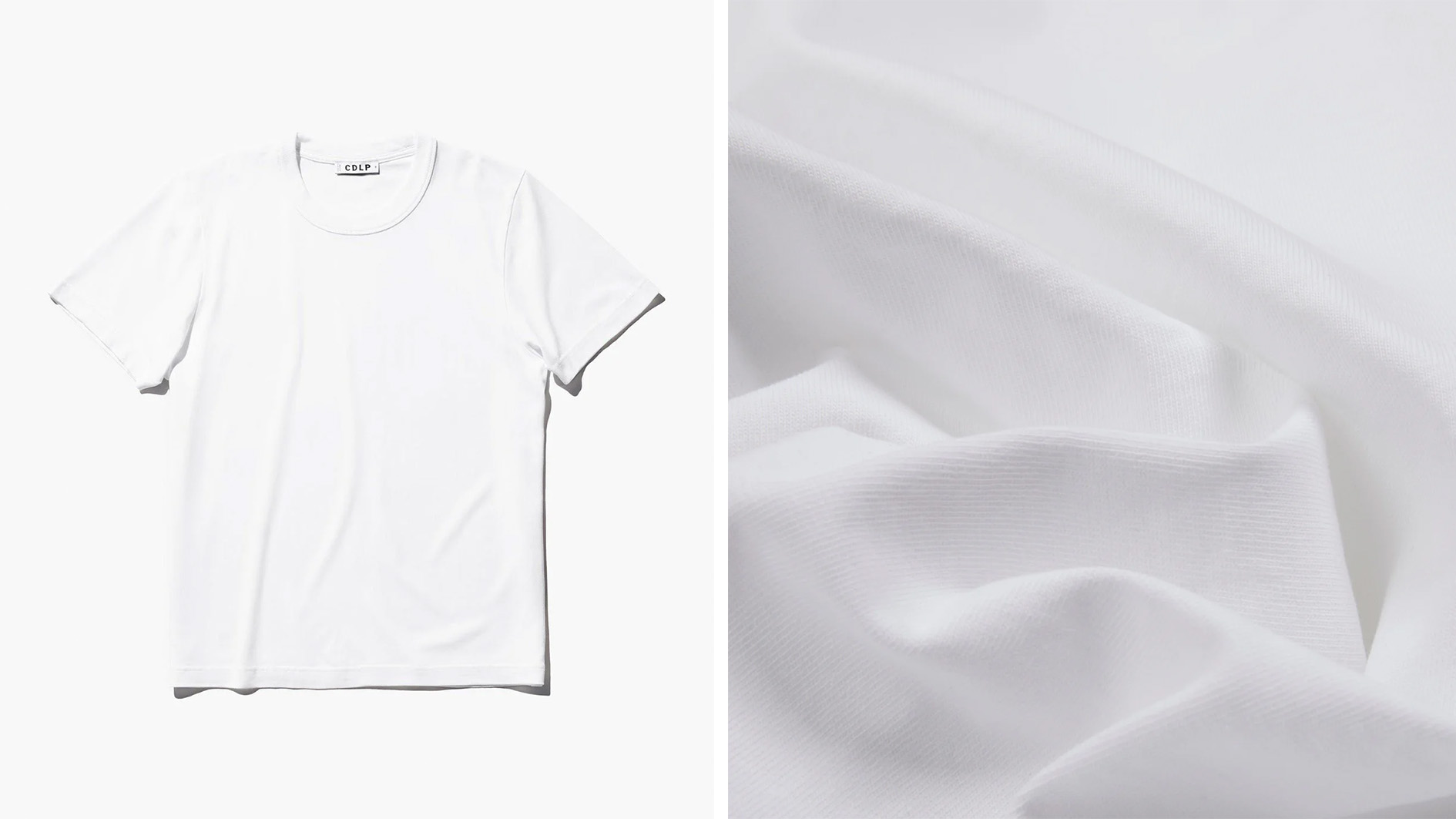 25 of the best white T-shirts, fashion’s most versatile staple
25 of the best white T-shirts, fashion’s most versatile stapleThe white T-shirt is the foundation of any good outfit, but finding the perfect one isn’t easy. We've curated a unisex list of our fashion desk’s favourite white tees, from cult favourites to luxurious classics
-
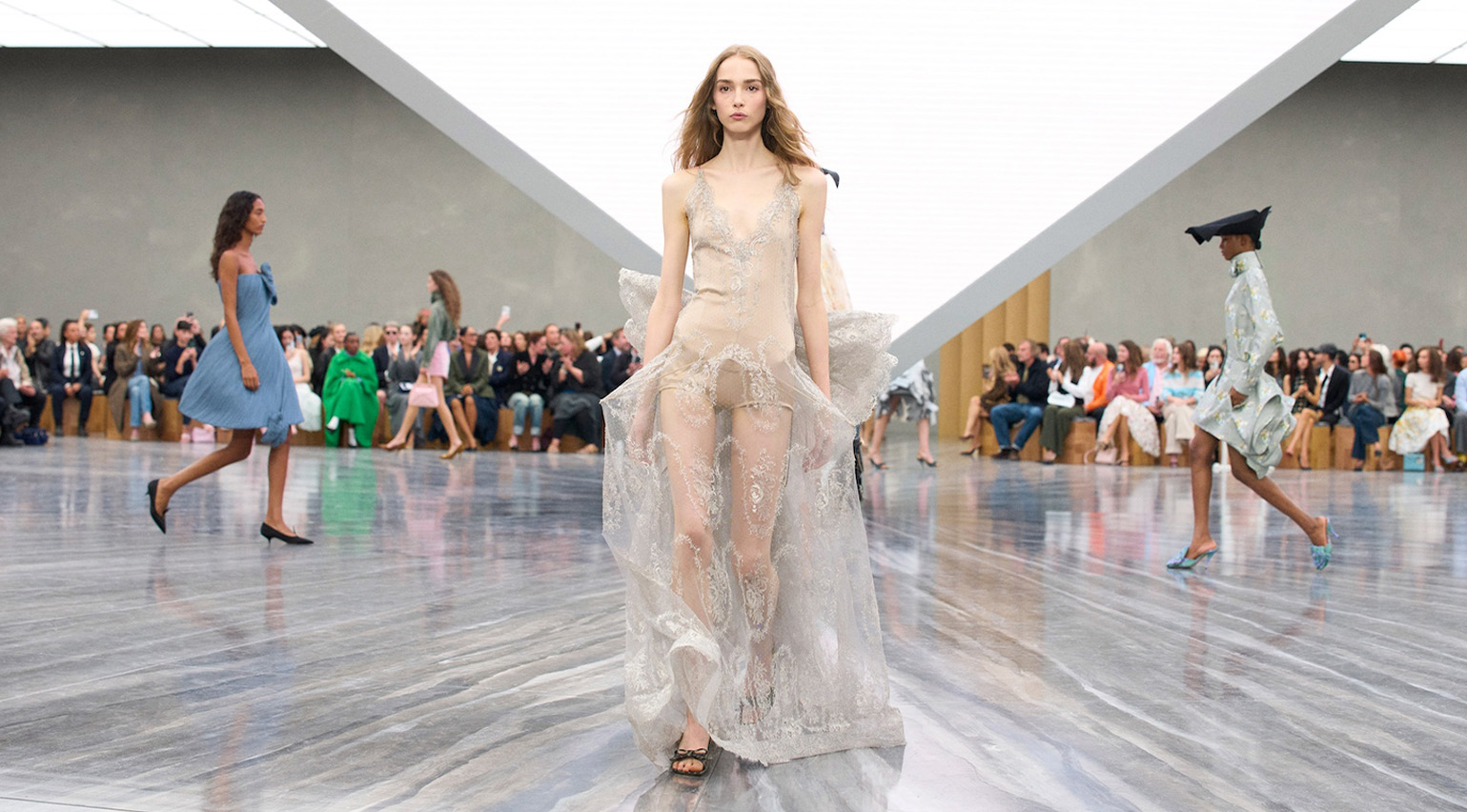 The key takeaways from the S/S 2026 shows: freedom, colour and romance define fashion’s new chapter
The key takeaways from the S/S 2026 shows: freedom, colour and romance define fashion’s new chapterWe unpack the trends and takeaways from the S/S 2026 season, which saw fashion embrace a fresh start with free-spirited collections and a bold exploration of colour and form
-
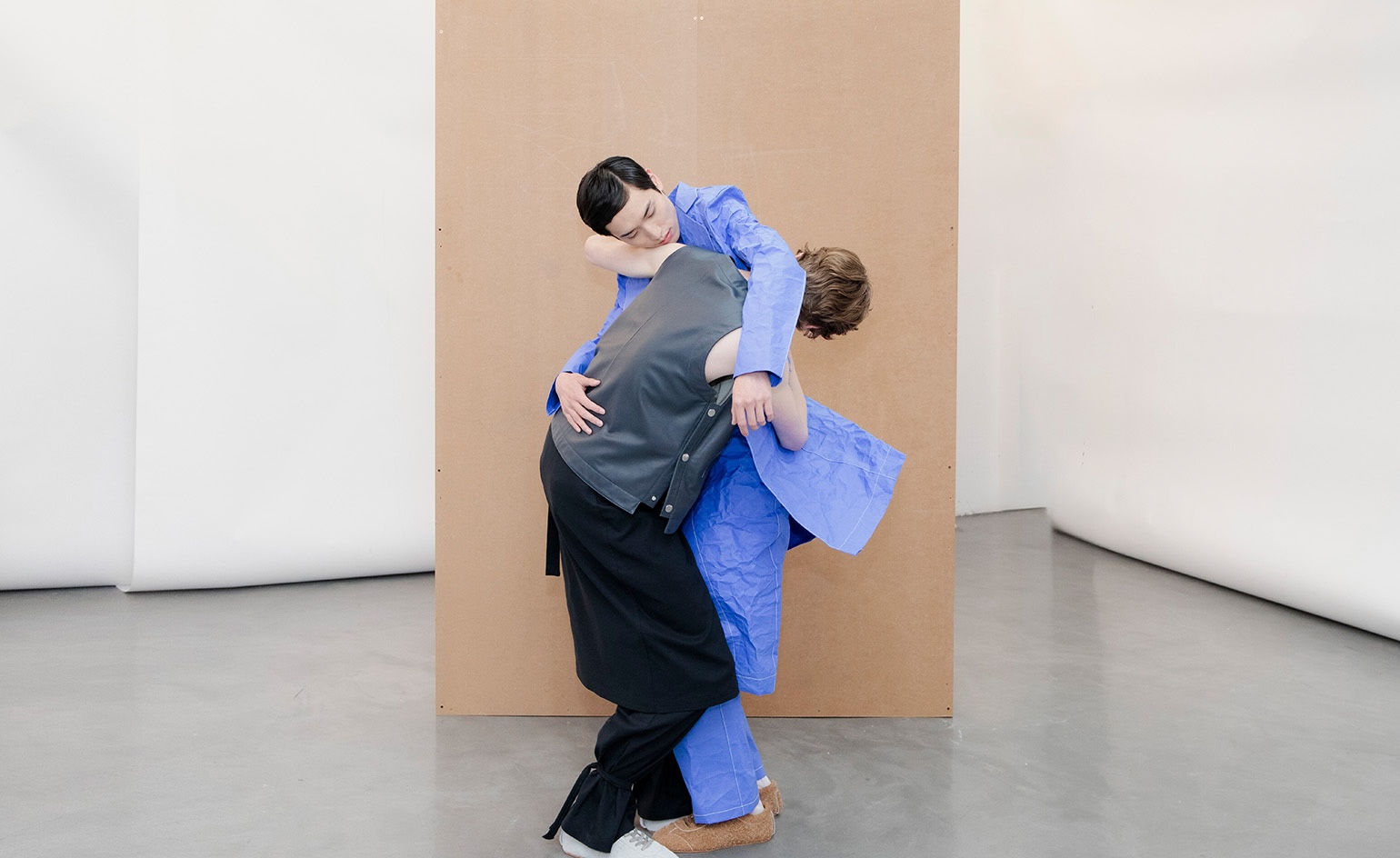 The independent designers you might have missed from fashion month S/S 2026
The independent designers you might have missed from fashion month S/S 2026Amid a tidal wave of big-house debuts, we take you through the independent displays that may have slipped through the cracks – from beautiful imagery to bookshop takeovers, museum displays and moves across the pond